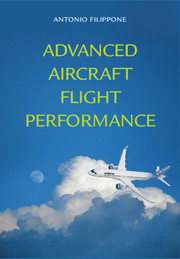Book contents
- Frontmatter
- Contents
- Tables
- Preface
- Nomenclature
- Technology Warning
- 1 Prolegomena
- 2 Aircraft Models
- 3 Weight and Balance Performance
- 4 Aerodynamic Performance
- 5 Engine Performance
- 6 Propeller Performance
- 7 Airplane Trim
- 8 Flight Envelopes
- 9 Take-Off and Field Performance
- 10 Climb Performance
- 11 Descent and Landing Performance
- 12 Cruise Performance
- 13 Manoeuvre Performance
- 14 Thermo-Structural Performance
- 15 Mission Analysis
- 16 Aircraft Noise: Noise Sources
- 17 Aircraft Noise: Propagation
- 18 Aircraft Noise: Flight Trajectories
- 19 Environmental Performance
- 20 Epilogue
- Appendix A Gulfstream G-550
- Appendix B Certified Aircraft Noise Data
- Appendix C Options for the FLIGHT Program
- Index
- References
6 - Propeller Performance
Published online by Cambridge University Press: 05 January 2013
- Frontmatter
- Contents
- Tables
- Preface
- Nomenclature
- Technology Warning
- 1 Prolegomena
- 2 Aircraft Models
- 3 Weight and Balance Performance
- 4 Aerodynamic Performance
- 5 Engine Performance
- 6 Propeller Performance
- 7 Airplane Trim
- 8 Flight Envelopes
- 9 Take-Off and Field Performance
- 10 Climb Performance
- 11 Descent and Landing Performance
- 12 Cruise Performance
- 13 Manoeuvre Performance
- 14 Thermo-Structural Performance
- 15 Mission Analysis
- 16 Aircraft Noise: Noise Sources
- 17 Aircraft Noise: Propagation
- 18 Aircraft Noise: Flight Trajectories
- 19 Environmental Performance
- 20 Epilogue
- Appendix A Gulfstream G-550
- Appendix B Certified Aircraft Noise Data
- Appendix C Options for the FLIGHT Program
- Index
- References
Summary
Overview
Aircraft propulsion by propeller is still the most widespread method of converting engine power into useful thrust. We seek the propeller parameters required to deliver specified thrust or power to the airplane (§ 6.1), depending on the flight condition. The simplest method for calculating the propulsive performance is the axial momentum theory (§ 6.2.1), which is useful when detailed data of the propeller itself are unknown. When detailed data are available, the combined momentum and blade element theory (§ 6.2.2), along with ancillary models for transonic flow, offers a powerful and accurate method for propeller analysis. The integration of the propeller with the flight mechanics is discussed in § 6.3. We show that when we trim to a specified thrust or power, the propeller generally does not operate at its most efficient point.
KEY CONCEPTS: Propeller Parameters, Propulsion Models, Momentum Theory, Blade Element Method, Flight Mechanics Integration, Propeller Installation.
Propeller Definitions
The basic parameters used in the analysis of the propeller are the forward speed U, the rotational speed rpm and the tip Mach number Mtip. In addition, there are several geometrical quantities: the number of blades, the diameter d, the pitch ϑ, the type of blade section, the chord distribution, the tip geometry and the hub geometry.
The pitch is a measure of the orientation of the propeller on a plane normal to the axis of rotation, as shown in Figure 6.1.
- Type
- Chapter
- Information
- Advanced Aircraft Flight Performance , pp. 152 - 178Publisher: Cambridge University PressPrint publication year: 2012
References
- 1
- Cited by



